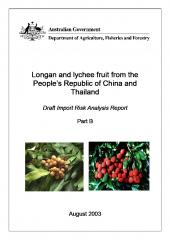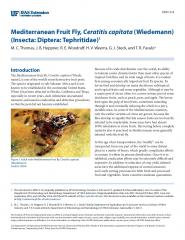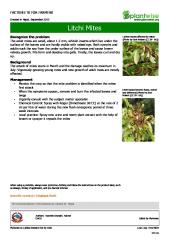Litchi chinensis or known in various common names such as litchi, lychee, liechee, liche, lizhi, or lichee is the only known species in the Litchi genus in the Sapindaceae family. It is a slow-growing, evergreen fruit tree with a dense and wide crown and can grow up to 28 m in height. It has a short bole with grey-black bark. The leaves are 10-25cm or longer, shiny, leathery, and light green but reddish when young. The fruit is fleshy, and covered by a pink-red, roughly textured rind. It varies in shape from round to ovoid to heart-shaped. It has a sweet and delicious flavor. It is usually consumed raw but it can also be dried or cooked. The fruit is also used in traditional medicine to threat throat discomfort, diarrhea, neuralgic disorders, and orchitis. The bark contains tannin. The wood is highly durable. Litchi is grown in East Asia particularly in southern China, Cambodia, Vietnam, and Philippines. It relatively matures slowly but it is long-lived. It is propagated by seed, air layering, greenwood cuttings, and grafting.
Litchi chinensis is an evergreen Tree growing to 12 m by 12 m at a slow rate.
It is hardy to zone 10 and is frost tender. The flowers are pollinated by Bees, Flies, Ants, Wasps.
It is noted for attracting wildlife.
Suitable for: medium and heavy soils and can grow in heavy clay soil. Suitable pH: acid and neutral soils and can grow in very acid soils.
It can grow in semi-shade or no shade. It prefers moist soil.
The litchi is adapted to the tropics and warm subtropics, producing best in regions with winters that are short, dry and cool but frost free, and summers that are long and hot with high rainfall. In the tropics it may thrive better at some elevation because of its requirement for winter chilling. It grows best in areas where annual daytime temperatures are within the range 20 - 35°c, but can tolerate 15 - 40°c. When dormant, the plant can survive temperatures down to about -5°c, but young growth can be severely damaged at -1°c. It prefers a mean annual rainfall in the range 1,000 - 1,700mm, but tolerates 700 - 2,800mm. A position in full sun is best for fruit production, but young plants grow better if they are given some shade. Plants are tolerant of a range of soil types, including heavy clays, so long as they are well drained, but grow best on deep, rich, acid soils that are rich in organic matter. They have succeeded on limestone soils when iron chelates have been added. Tolerant of wet soils, providing the water is not stagnant. Plants require a position that is sheltered from the wind, especially when they are young. Prefers a pH in the range 5.5 - 6.5, tolerating 5 - 8.5. Most varieties need between 50 - 150 hours of standard chilling at 0 - 10°c. The trees have a positive requirement for winter chilling to between 7 - 12°c, and a dormancy period to induce flowering. Various cultivars have been developed with differing degrees of winter chilling requirements. Plants are slow to mature, but are long-lived. Seedling trees take 8 - 12 years before they commence fruiting. Grafted trees can commence fruiting when 2 - 5 years old, though full cropping does not take place until the trees are 20 - 40 years old and they can continue cropping for 100 years or more. Fruit yields for 10-year-old trees range from 10 - 80 kg/tree, or 0.7 - 11.2 tonnes/ha. Average yields are often only about 2 tonnes/ha. There are many named varieties. Flowering Time: Mid Spring. Bloom Color: Inconspicuous/none . Spacing: 15-20 ft. .
HabitatsThe tree has been in cultivation for so long that wild forms are no longer believed to exist.Resources
draftb llira

Longan and lychee fruit from the
People’s Republic of China andThailand
Draft Import Risk Analysis Report
Part B
August 2003
http://www.agriculture.gov.au/SiteCollectionDocuments/ba/memos/2003/plant/draft…draftb lliradraftb llira
Longan and lychee fruit from the
Australian Government Department of Agriculture
People’s Republic of China and
Thailand
Draft Import Risk Analysis Report
Part B
August 2003IN37100

EENY-214
Mediterranean Fruit Fly, Ceratitis capitata (Wiedemann)
(Insecta: Diptera: Tephritidae) 1https://edis.ifas.ufl.edu/pdffiles/IN/IN37100.pdfIN37100IN37100
EENY-214
EDIS - Electronic Data Information Source - UF/IFAS Extension
Mediterranean Fruit Fly, Ceratitis capitata (Wiedemann)
(Insecta: Diptera: Tephritidae) 1Litchi Mites

FACTSHEETS FOR FARMERSCreated in
Nepal
,
September2013
Litchi Mites
Cabi Plantwise Knowledge Bankhttps://www.plantwise.org/KnowledgeBank/factsheetforfarmers/20147801448Litchi MitesLitchi mites
FACTSHEETS FOR FARMERS
Cabi Plantwise Knowledge Bank
www.plantwise.org
Created in
Nepal
,
September
2013
Litchi Mites
Major pests
- Aceria litchii
Adoretus versutus
Amblypelta lutescens
Amblypelta nitida
Armillaria tabescens
Attacus atlas
Conopomorpha sinensis
Coptotermes
Criconemella
Cryptophlebia illepida
Cryptophlebia ombrodelta
Cuscuta reflexa
Epiphyas postvittana
Eudocima fullonia
Euphorbia hirta
Ferrisia virgata
Hemicriconemoides mangiferae
Homona coffearia
Indarbela dea
Lymantria mathura
Lyramorpha rosea
Megalurothrips distalis
Mikania micrantha
Mimosa diplotricha
Peronophythora litchii
Pulvinaria psidii
Saissetia coffeae
Statherotis discana
Tessaratoma papillosa
Thaumatotibia leucotreta
Trichodorus
Xiphinema americanum
Xylotrupes gideon
Paratachardina silvestri
Thaumatotibia leucotreta
Minor pests
- Aleurocanthus woglumi
Anisodes illepidaria
Aonidiella orientalis
Aphis gossypii
Apoderus blandus
Aspergillus niger
Bactrocera tryoni
Biston suppressaria
Brevipalpus phoenicis
Ceratitis capitata
Ceratitis rosa
Ceroplastes rubens
Ceroplastes rusci
Chaetanaphothrips orchidii
Colletotrichum siamense
Cricula trifenestrata
Dudua aprobola
Erythricium salmonicolor
Eumeta crameri
Euwallacea fornicatus
Glomerella cingulata
Gymnandrosoma aurantianum
Icerya seychellarum
Indarbela quadrinotata
Isotenes miserana
Lymantria dispar
Marasmiellus scandens
Monolepta australis
Orgyia postica
Perixera illepidaria
Pseudococcus jackbeardsleyi
Pseudotheraptus wayi
Rotylenchulus reniformis
Scirtothrips dorsalis
Selenaspidus articulatus
Tylenchorhynchus claytoni
